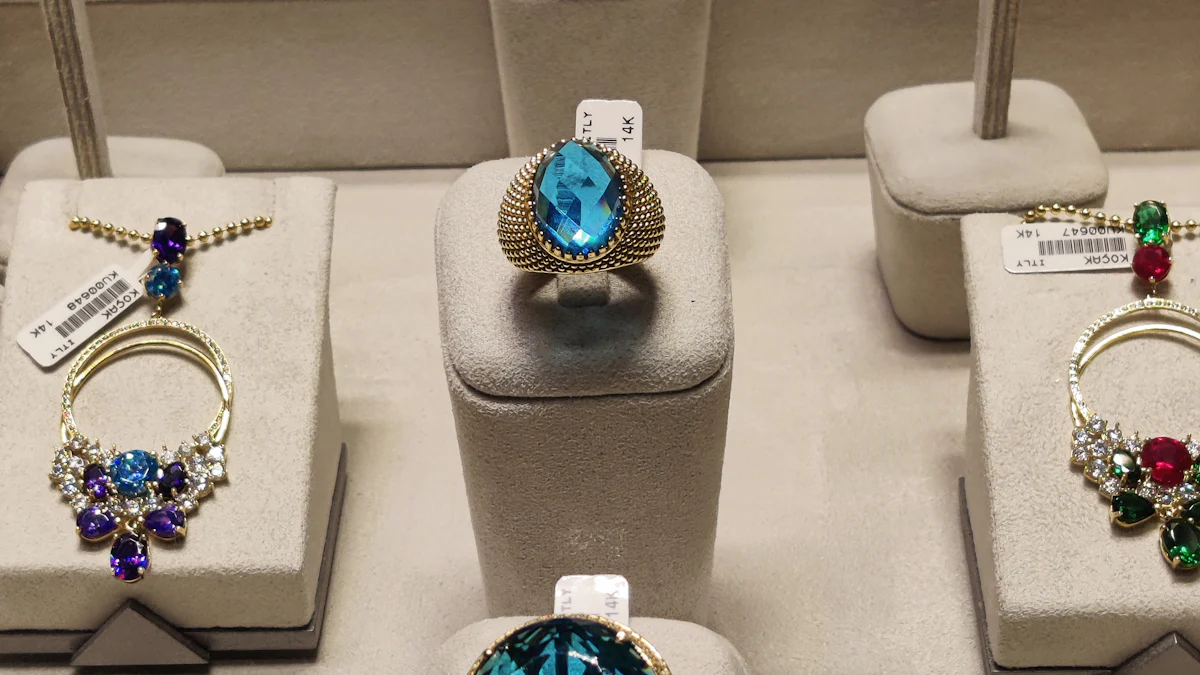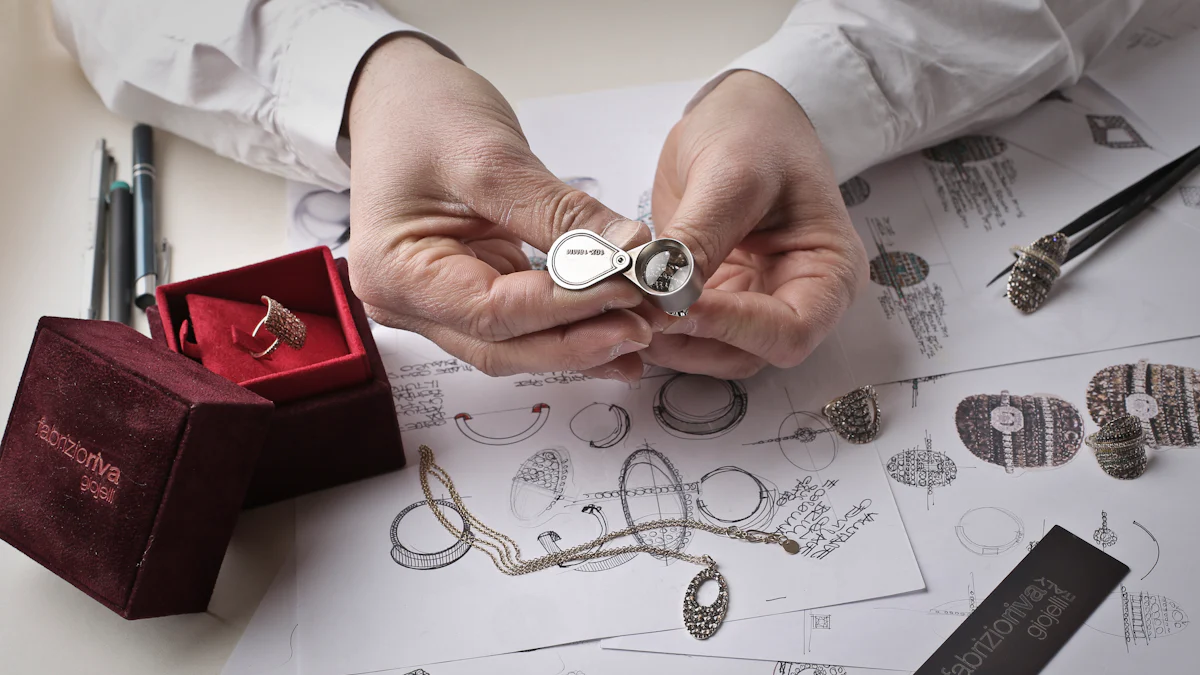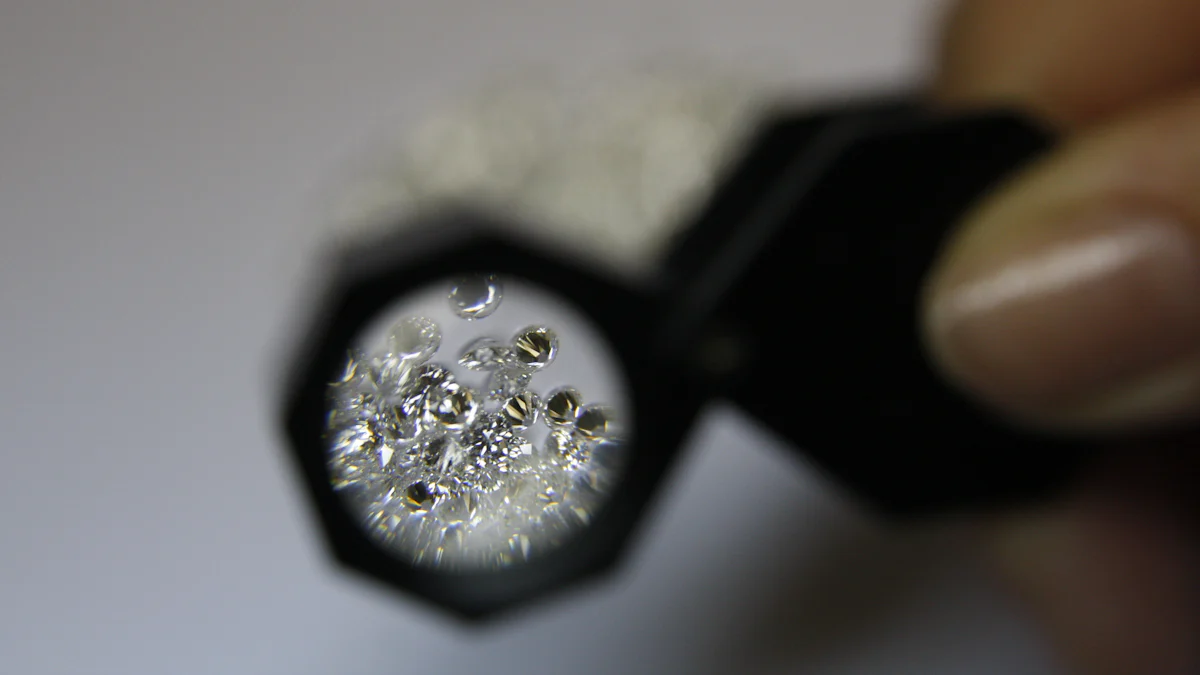Tips for Evaluating Jewelry Based on Carat TW Meaning

When you shop for jewelry, you might notice the term "carat total weight" or CTTW. But what does carat TW mean? It’s a measurement that tells you the combined weight of all gemstones in a piece. This detail helps you understand the visual impact and value of the jewelry. Knowing CTTW ensures you’re not just dazzled by sparkle but also making a smart purchase. It’s not just about size; it’s about understanding how each stone contributes to the overall beauty and worth of the piece.
What Does Carat TW Mean?

Definition and Calculation of Carat Total Weight
Carat total weight, often abbreviated as CTTW, represents the combined weight of all gemstones in a piece of jewelry. This measurement includes every diamond or gemstone, whether it’s the centerpiece or smaller accent stones. For example, if you’re looking at a diamond necklace with CTTW 1.25 carats, the total weight comes from a 0.75-carat center diamond and smaller accent diamonds weighing 0.25 carats each.
To calculate CTTW, jewelers add up the weight of all individual stones in the piece. A Whiteflash engagement ring with a 1-carat center diamond and smaller accent diamonds totaling 0.5 carats would have a CTTW of 1.5 carats. This calculation helps you understand the overall size and value of the jewelry.
Difference Between CTTW and Individual Carat Weight
While CTTW gives you the total weight of all gemstones, individual carat weight focuses on a single stone. This distinction matters when evaluating jewelry. For instance, a ring with a 0.5-carat diamond flanked by two 0.25-carat side stones has a CTTW of 1 carat. However, the center diamond’s individual carat weight is 0.5 carats.
Understanding this difference ensures you know whether the piece features a large, prominent stone or multiple smaller ones. When buying earrings, dividing the CTTW by two reveals the weight of each earring’s stones. For example, Adiamor diamond halo earrings with a CTTW of 1.20 carats mean each earring holds 0.60 carats of diamonds.
Importance of CTTW in Jewelry Evaluation
CTTW plays a crucial role in determining a piece’s value and appearance. Larger total weights often indicate more brilliance and higher prices. For example, a 1/4 CTTW diamond jewelry piece means the total weight of all diamonds is one-quarter of a carat, which might be less expensive than a piece with a higher CTTW.
However, CTTW doesn’t tell the whole story. You should also consider the quality, cut, and arrangement of the stones. A ring with a 1-carat center stone surrounded by poorly cut accent diamonds might not sparkle as much as a well-crafted piece with smaller, high-quality stones. Always ask for a breakdown of the carat weight for each stone to get a clearer picture of the jewelry’s value.
Practical Tips for Evaluating Diamond Carat and Jewelry Based on CTTW

Assessing Gemstone Size and Uniformity
When you evaluate jewelry, gemstone size and uniformity play a big role in its overall appeal. The carat total weight gives you the combined weight of diamonds or gemstones in a piece, but it doesn’t tell you how evenly the stones are distributed. For example, a necklace with a total carat weight of 2 carats might feature one large diamond surrounded by smaller, unevenly sized stones. This can affect the symmetry and visual balance of the jewelry.
To assess uniformity, look closely at the gemstones. Are they similar in size and shape? Uniform stones often create a more harmonious and polished appearance. If you’re buying earrings, divide the carat total weight by two to ensure each earring has an equal share of the combined weight of diamonds. This step helps you avoid mismatched pieces that might look unbalanced when worn.
Understanding How CTTW Impacts Pricing
The carat total weight significantly influences the price of jewelry. Larger total weights often mean higher costs, but the value isn’t solely about size. Diamond quality matters just as much. A piece with a smaller carat weight but exceptional cut, color, and clarity can outshine a larger, lower-quality piece. For instance, a ring with a total carat weight of 1.5 carats might cost less than a 1-carat ring if the latter features superior diamond quality.
When evaluating diamond carat and pricing, ask for a breakdown of the carat weight for each stone. This transparency helps you understand what you’re paying for. A piece with a high carat total weight but poorly cut stones might not sparkle as much as a smaller, well-crafted piece. Always balance size with quality to ensure you’re getting the best value for your money.
Verifying the Quality of Gemstones Beyond CTTW
Carat total weight is just one factor in determining a piece’s value. You also need to verify the quality of the gemstones. Focus on the “Four Cs” of diamond quality: cut, color, clarity, and carat weight. While the combined weight of diamonds gives you an idea of size, the cut determines how well the stones reflect light. A poorly cut diamond with a high carat total weight might appear dull compared to a smaller, brilliantly cut stone.
Color and clarity also impact the overall beauty of the jewelry. Look for stones with minimal inclusions and a clear, vibrant appearance. Don’t let a high total carat weight distract you from these essential details. If possible, consult a professional appraiser to confirm the quality of the gemstones. They can provide insights beyond what’s visible to the naked eye, ensuring you make an informed purchase.
Working with Professionals to Evaluate Jewelry
When it comes to evaluating jewelry, working with professionals can make all the difference. They bring expertise and tools that help you understand the true value of your piece. Whether you're buying, selling, or simply curious about your jewelry, collaborating with an experienced appraiser ensures you get accurate insights.
Choosing a Qualified Appraiser
Finding the right appraiser is essential. Not all appraisers have the same level of expertise, so you need to choose carefully. Look for someone with certifications from reputable organizations like the Gemological Institute of America (GIA) or the American Society of Appraisers (ASA). These credentials show that the appraiser has undergone rigorous training and adheres to industry standards.
Ask about their experience with the type of jewelry you want evaluated. For example, if you're assessing a diamond ring, the appraiser should have a strong background in diamonds. A qualified professional will also provide a written, detailed jewelry appraisal that outlines the carat total weight (CTTW), gemstone quality, and overall value. This document can be invaluable for insurance purposes or resale.
"CTTW is crucial but not the sole factor in determining jewelry value. Cut, color, clarity, and design also play significant roles," says a gemologist. A skilled appraiser will consider all these factors, ensuring you get a comprehensive evaluation.
Questions to Ask About Carat Total Weight During an Appraisal
During the appraisal process, asking the right questions helps you gain a deeper understanding of your jewelry. Start by inquiring about the breakdown of the carat total weight. For instance, if a necklace has a CTTW of 2 carats, ask how much weight comes from the center stone versus the smaller accent stones. This information gives you a clearer picture of the piece's composition.
You should also ask how the appraiser evaluates the quality of the gemstones. While CTTW provides an idea of size, it doesn't reflect the cut, color, or clarity of the stones. A professional appraiser will explain how these factors influence the overall value. Additionally, ask if the appraisal includes details about the craftsmanship and design of the jewelry. These elements can significantly impact its worth.
Finally, don't hesitate to ask for advice on maintaining or enhancing the value of your jewelry. A good appraiser will offer tips on proper care and storage, ensuring your piece retains its beauty and value over time.
When to Seek a Second Opinion and Compare Evaluations
Sometimes, getting a second opinion is the best way to ensure accuracy. If you're unsure about an appraisal or feel the valuation doesn't match your expectations, consult another appraiser. Different professionals may have varying perspectives, especially when it comes to subjective factors like design and craftsmanship.
Comparing evaluations can also help you spot inconsistencies. For example, one appraiser might focus heavily on the CTTW, while another emphasizes the quality of the gemstones. By reviewing multiple appraisals, you gain a more balanced understanding of your jewelry's value.
Seeking a second opinion is particularly important for high-value pieces. The more valuable the jewelry, the more critical it becomes to have a thorough and accurate assessment. Remember, an appraisal isn't just about numbers; it's about understanding the story behind your jewelry and what makes it unique.
Understanding carat total weight (CTTW) is key to making smart jewelry decisions. It helps you evaluate the overall value of a piece and ensures you know what you’re paying for. By focusing on CTTW, you can better assess the diamond price per carat and its impact on value. Use the practical tips shared here to examine gemstone quality, understand pricing variations, and balance size with craftsmanship. Don’t hesitate to consult professionals for accurate evaluations. With this knowledge, you’ll confidently choose jewelry that matches your style and budget.
FAQ
What is CTTW and How is it Different from Carat?
CTTW, or carat total weight, refers to the combined weight of all diamonds or gemstones in a piece of jewelry. In contrast, carat measures the weight of a single stone. For example, a ring with a 0.5-carat center diamond and two 0.25-carat side stones has a CTTW of 1 carat. Understanding this difference helps you evaluate whether a piece features one prominent stone or multiple smaller ones.
Why is CTTW Important When Buying Jewelry?
CTTW gives you an idea of the overall size and value of a jewelry piece. A higher CTTW often means more brilliance and a higher price. However, it’s not the only factor to consider. The quality of the diamonds or gemstones, including their cut, color, and clarity, plays a significant role in determining the piece’s beauty and worth.
Does CTTW Include Non-Diamond Gemstones?
No, CTTW typically refers only to the total weight of diamonds in a piece of jewelry. If the piece includes other gemstones, you should ask for a breakdown of their individual weights. This ensures you understand the composition and value of the jewelry.
How Does CTTW Impact the Price of Jewelry?
The price of jewelry increases with a higher CTTW, but size isn’t everything. A smaller piece with exceptional diamond quality can cost more than a larger piece with lower-quality stones. Always balance size with craftsmanship and quality to ensure you’re getting the best value.
Can Two Pieces with the Same CTTW Look Different?
Yes, two pieces with the same CTTW can appear very different. One might feature a single large diamond, while the other has multiple smaller stones. The arrangement, cut, and quality of the stones also affect the piece’s appearance and sparkle.
How Can I Verify the Quality of Diamonds Beyond CTTW?
Focus on the “Four Cs” of diamond quality: cut, color, clarity, and carat weight. While CTTW tells you the total weight, the cut determines how well the diamonds reflect light. A poorly cut diamond with a high CTTW might look dull compared to a smaller, brilliantly cut stone.
What Should I Ask a Gemologist About CTTW?
When consulting a gemologist, ask for a detailed breakdown of the carat total weight. Find out how much weight comes from the center stone versus the accent stones. Also, inquire about the quality of the diamonds, including their cut, color, and clarity. This information helps you make an informed decision.
Is It Necessary to Divide CTTW for Earrings?
Yes, dividing the CTTW by two helps you determine the weight of the stones in each earring. For example, earrings with a CTTW of 1/4 cttw mean each earring contains 1/8 cttw of diamonds. This ensures you know what you’re buying and helps avoid mismatched pieces.
What’s the Difference Between Fair Market Value and Replacement Value?
Fair market value represents the price you’d get if you sold the jewelry. Replacement value is the cost to replace the piece with one of similar quality and design. Both values are important, especially for insurance purposes. A professional appraisal can provide clarity on these terms.
When Should I Seek a Second Opinion on Jewelry Appraisal?
If you’re unsure about an appraisal or feel the valuation doesn’t match your expectations, seek a second opinion. This is especially important for high-value pieces. Comparing evaluations from different professionals ensures accuracy and helps you understand the true value of your jewelry.
See Also
Comprehensive Analysis of 5 Carat Lab Grown Diamond Bracelet
Exploring Different Diamond Cuts for Engagement Rings
What Is the Price of a 2 Carat Lab Grown Diamond

